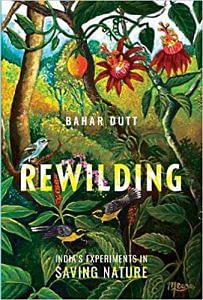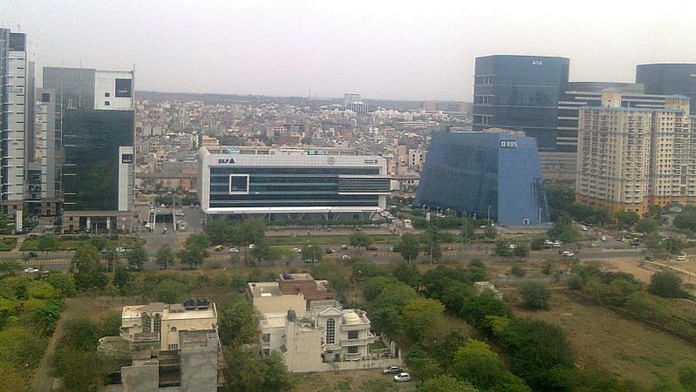In this chapter, I set out to explore two examples of ecological restoration in urban settings, in Delhi and in Bengaluru. The first is an urban restoration/ rewilding project on a patch of forest taken up a group of citizens just on the edge of Delhi. The suburban city of Gurugram in north India, known for its high crime rate, massive traffic snarls, and snazzy high-rise corporate offices, symbolizes all that is going wrong with a city— poor planning, a depleting water table, and virtually no public transport. But an enthusiastic bunch of citizens have organized themselves under the banner of ‘I AM GURGAON’ to turn things around. Leading this group is 45-year-old Latika Thukral, a banker who gave up a corporate job to pursue her dream of setting up an NGO for a greener city—Gurugram, her home for the last 16 years. Over the past decade, the organization has succeeded in healing nearly 550 acres of land and turning it into the Aravali Biodiversity Park. Today, the park is a repository for native flora and fauna of the Aravalis; it has a water-conservation zone, an educational space to spread awareness about environmental issues— particularly among children—and a recreational space as well. In one visit to the park you can encounter a mixed coterie of people, from the morning walker to the avid birdwatcher.
The Aravalis once extended from Gurugram in Haryana all the way to Rajasthan and Gujarat, covering over 700 kilometres, and had their own unique biodiversity. Over the years, parts of the Aravalis, especially in Haryana, have been ravaged or lost due to rampant mining. Latika and her team decided to change all that. They could have just built an urban park for their morning walks. But they went a step further—and entered into a partnership with the government to build a biodiversity park. This meant planting indigenous trees and bringing back local species typical to the Aravalis. Now, with over 150–200 species of native trees, shrubs, herbs, climbers, and grasses; over 170 species of birds (black kite, shrike, drongo, sparrow and bulbul); and animals like the civet cat, jackal, nilgai, porcupine, hare, and mongoose, the biodiversity park is teeming with life. ‘Our vision was to give Gurugram something it could cherish. Greenery was the answer since Gurugram is located in the Aravali ranges and used to be lush and green, before the hills were ravaged by extensive mining,’ explains Latika. ‘We took over the park in 2009 from the Haryana forest department, and since then, the survival rate of saplings has increased from 10 per cent to 40 per cent, which has encouraged us a lot.’
And encouragement was definitely the need of the hour: Latika and her friends faced many and varied roadblocks along the way, from administrative apathy to scarcity of water. Water was initially a big challenge. However, more than 40 companies in Gurugram provided them with adequate funds to nurture saplings. ‘At present, we have two nurseries inside the park to grow saplings. We have one borewell inside the park and the rest we manage with treated water given to us by a local company,’ she says. Plants must be selected carefully as random planting can do more harm than good. To remedy this, Latika planted trees that were once part of this ecosystem.
To many, the term rewilding or ecological restoration means planting trees or reviving a habitat. In this case, Latika and her team had to turn things on their head— and, rather ironically, begin by ridding the landscape of a profusion of vilayati kikar. This native Mexican tree species was introduced by the British in the 1800s to beautify the newly declared capital. The motive behind choosing this specific species was that it could adapt easily to the region’s arid soil. However, the kikar caused great damage, wiping out local species and depleting the water table wherever it was planted. And that’s how Latika and her team, advised by environmentalists, came to uproot this alien species before any actual work could be done.
This massive deforestation drive entailed working with the State forest department to change their mindset. The next step was finding people to donate saplings, to be planted over the 500 acres. That’s where Latika’s corporate background came in handy. She reached out to businesses with offices in Gurugram, who stepped up and donated in large numbers. The next step was finding a source of water. Though there was a borewell, they didn’t want to exploit a depleting water table, as that would only add to their woes. So she made arrangements for drip irrigation, which had never been tried before for such a large area, and one which was undulating in parts. It worked. Now, they have an arrangement for using water from the Gurugram sewage treatment plant.
The Gurugram Municipal Corporation helped by fencing the entire park and solving many encroachment-related issues with locals from surrounding villages. Working with the government has had its ups and downs. While some officers have been co-operative, others had their own ideas of how to manage a park. Says Latika, ‘One officer suggested having an open-air gymnasium, another wanted to build a night safari, and a third wanted to open a crocodile park. But by and large, we were able to bring them around to our concept of how we want to run this park.’
Renowned naturalist Vijay Dhasmana has been working with Latika and her team, spearheading the plantation drives, sourcing native species, and building the nursery, among other responsibilities. He believes that Latika and her team’s work stands out for its emphasis on restoring ecosystem services and wanting to bring back the native species of the Aravalis. ‘This is not just a recreational space,’ he explains. ‘The 550 acres are helping recharge a severely depleted ground water table for Gurugram. Moreover, we have helped bring back so many species that were once common to the Aravalis, such as Boswellia serrata (salai), Sterculia urens (kullu), Mitragyna parvifolia (kaim), Lannea coromendelica (gurjan), and Anogeissus pendula (dhau).
The citizen’s initiative hasn’t stopped just at restoring the Aravali Biodiversity Park. Propelled by the success of the park, they are now greening an abandoned storm-water drain or bundh that was once part of an ancient irrigation system built during the British Raj. Most of these bundhs or irrigation channels have become clogged with mountains of plastic, as they were being used largely as dumping grounds. Latika’s team in 2017 removed 250 truckloads worth of plastic and debris from the drain.
The rejuvenation of the Chakkarpur–Wazirabad Bandh uses an integrated system for proper collection and discharge of rainwater. The drainage system includes recharge chambers, channels, trenches, pits, and perforated pipes to ensure that rainwater flows in the right direction and recharges the ground water table as well as the nullah. The project used 1,900 tractors of debris and 480 trucks of soil brought from various sites in and around Gurugram. Nearly 5,000 cubic metres of construction and demolition waste was used effectively, ensuring a reduction in dumping of roadside waste and efficient utilization of resources. The corridor has been restored by planting indigenous trees and developing a cycling track for the residents. Latika proudly states that a 1,020-metre stretch of bundh land has been transformed into a linear urban park in a span of one year.
The idea was to transform the bundh into a green corridor, much like The High Line Park in New York City has rejuvenated the disused Central Rail line into a 2.33-kilometre-long aerial greenway. Already, many pedestrians of all age groups use this stretch of the bundh daily, both as free public space and to walk across to the other side.
Also read: Gurugram’s own Chipko movement: 1,200 residents protest to protect Aravali Biodiversity Park
As with any urban green initiative, the success of the Aravali Biodiversity Park—as also the bundh project—rested on a number of critical facts. One, in the case of the biodiversity reserve, the unique partnership with the government allowed the NGO to focus on conservation aspects rather than get caught up in legal or infrastructural entanglements. The fact that the project had the backing of the government made interventions easier for them. Another is the involvement of local residents so that there is a sense of ownership over the project. That also explains the unprecedented popularity that the park enjoys among the citizens of Gurugram, who, in November 2018, showed up in the thousands to protest a proposal by the National Highway Authority of India (NHAI) to build an elevated road that would have wiped out the park. It was because of the citizens’ protest that NHAI finally had to back off and come up with an alternate plan that would not destroy the green lung.
 This excerpt from Rewilding: India’s Experiments in Saving Nature by Bahar Dutt has been published with permission from Oxford University Press.
This excerpt from Rewilding: India’s Experiments in Saving Nature by Bahar Dutt has been published with permission from Oxford University Press.



